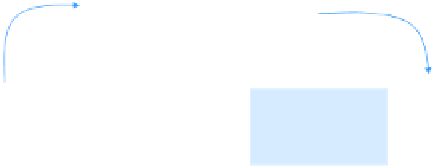Information Technology Reference
In-Depth Information
multimedia framework. Figure 13 depicts each stage to create the 3D home-
shopping contents for future broadcasting.
…
Depth camera data
…
Hybrid camera system
Video-plus-depth
Comp uter graphic models
MPEG-4 system
Streamable 3D video contents
Fig. 13
3D home-shopping contents generation
In the 3D home-shopping contents, the geometric and photometric information
of a home-shopping host had been derived from video-plus-depth data generated
by the hybrid camera system. The video-plus-depth information was encoded by
two H.264/AVC coders [25]. In order to render the home-shopping host into a 3D
scene, we used hierarchical decomposition of depth images. The advertised prod-
uct, a sofa, and the background of the home-shopping channel stage were repre-
sented by computer graphic models. The sofa was represented by a 3D mesh
model composed of 4,774 vertices and 2,596 triangular faces. All computer
graphic models were encoded by a MPEG-4 BIFS coder.
In this experiment, it was possible to stream the 3D home-shopping contents
through a network after setting up a streaming server [26]. Moreover, since we
successfully represented a real and natural object, a home-shopping host, with
video-plus-depth and rapidly rendered it into a dynamic 3D scene, we could serve
the immersive contents to users and support a variety of interactive functionality
in the MPEG-4 multimedia framework.
As shown in Fig. 14(a), the home-shopping contents could provide a 3D view
to users by freely reallocating the position of a virtual camera in 3D space. In ad-
dition, as shown in Fig. 14(b), since the home-shopping host based on video-plus-
depth data was described by a newly-designed MPEG-4 BIFS node
DepthMovie
,
the natural 3D actor could be easily combined with computer graphic images, a































































